Falstaff Brewery No. 10
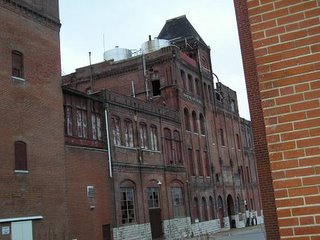
Most people in St. Louis are familiar with the historic Lemp Brewery. In some ways, I think this could just be due to the tragic history of the family. On one of my recent explorations, I met up with my new exploring buddy Chris for the first time, and he suggested we go to the old Falstaff Brewery. I'm always game for anything, but I did have to admit that I was not familiar with the place. Truthfully, I had never even heard of it. As we had both read the book The Lost Caves of St. Louis, he explained to me that this was most likely the site of the old Consumer's Brewery Cave. Ever since I read that book, it has been a desire of mine to set foot into one of the many histo
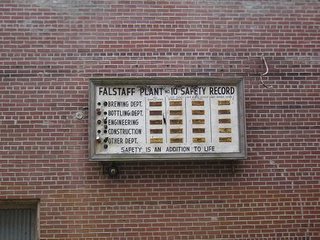 ric caves that stretch beneath the streets of St. Louis. As we drove to the brewery, I expected a small and rather uninteresting building. I could never have imagined how amazing our day was about to become.
ric caves that stretch beneath the streets of St. Louis. As we drove to the brewery, I expected a small and rather uninteresting building. I could never have imagined how amazing our day was about to become.The first brewery on this site was called Stumpf's Brewery, and was built in 1853. In 1877, Stumpf sold the brewery to Thamer Brewing Company, and it contined to change hands throughout the years: A. Griesedieck and Company, Miller Bros. Brewing Company, Consumer Brewing Company (for which the cave is named), and then back to the Griesediecks. At that time, in 1911, it became known as the Griesedieck Brother's Br
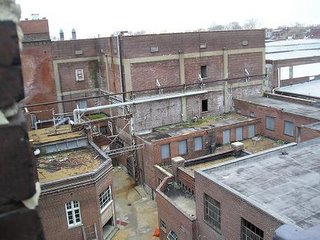 ewery. I do know that eventually the brewery came under control of Falstaff and was known as Falstaff Brewery No. 10. What I'm not sure about are exact dates: when Falstaff took over or when the plant eventually shut down. I know that most of the Falstaff Breweries began closing in the late 70s, so I can only assume that this one was no different. Another interesting point is that the Lemp Beer crest that is still visible on some of the buildings at the Lemp Brewery is almost exactly like the Falstaff Crest. Chris said that this was because they were both arms of the same company. I'd appreciate it if anyone could shed some light on this for me.
ewery. I do know that eventually the brewery came under control of Falstaff and was known as Falstaff Brewery No. 10. What I'm not sure about are exact dates: when Falstaff took over or when the plant eventually shut down. I know that most of the Falstaff Breweries began closing in the late 70s, so I can only assume that this one was no different. Another interesting point is that the Lemp Beer crest that is still visible on some of the buildings at the Lemp Brewery is almost exactly like the Falstaff Crest. Chris said that this was because they were both arms of the same company. I'd appreciate it if anyone could shed some light on this for me.What I noticed as Chris and I approached the site was how massive it was! I c
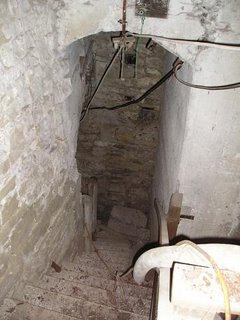 ould not believe that I had never noticed it before, since it is located right off of Interstate 55. Walking into the place was amazing, as the tall buildings seem to circle in around you on all sides. As we entered the first building, Chris almost immediately found the entrance to the Comsumer's Brewery Cave. Descending the old stairs into the cave is an experience I'll never forget. One always hears about the caves that lie under the city, but that seems almost like another realm of existence, one normal people will never get to see. I couldn't believe I was doing it! The wooden staircase led to a small chamber with brances off in three directions. There were a few lower chambers of the cave, but they seemed to be completely full of water. The book Lost Caves of St. Louis talks about the spring that was once located in the cave, and Chris and I noticed that the water was clear and moving. We assumed that this had something to do with the spring. One of the rooms led to a large machine that we decided must have been some kind of cooling unit. Then again, what do we know?
ould not believe that I had never noticed it before, since it is located right off of Interstate 55. Walking into the place was amazing, as the tall buildings seem to circle in around you on all sides. As we entered the first building, Chris almost immediately found the entrance to the Comsumer's Brewery Cave. Descending the old stairs into the cave is an experience I'll never forget. One always hears about the caves that lie under the city, but that seems almost like another realm of existence, one normal people will never get to see. I couldn't believe I was doing it! The wooden staircase led to a small chamber with brances off in three directions. There were a few lower chambers of the cave, but they seemed to be completely full of water. The book Lost Caves of St. Louis talks about the spring that was once located in the cave, and Chris and I noticed that the water was clear and moving. We assumed that this had something to do with the spring. One of the rooms led to a large machine that we decided must have been some kind of cooling unit. Then again, what do we know?In one room, there was some sort of split level entrance, with one part going
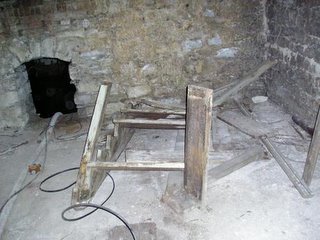 to an upper chamber and one going to a lower, and of course flooded, chamber. Wanting to reach the upper chamber, I told Chris that we should attempt to prop the fallen wooded stairs that were lying to the side back up against the wall. When we tried, the whole thing fell apart at once, like something out of a cartoon. We found another way, though, as Chris found an old ladder. What I found interesting about the ladder was that the steps on the ladder were completely covered with calcite deposits, which leads me to believe that the cave is still alive. Despite all man's interference, nature continues to relcaim it's areas. The upper chamber of that we found had a curved ceiling and lots of left over equipment, and also provided us a look up at
to an upper chamber and one going to a lower, and of course flooded, chamber. Wanting to reach the upper chamber, I told Chris that we should attempt to prop the fallen wooded stairs that were lying to the side back up against the wall. When we tried, the whole thing fell apart at once, like something out of a cartoon. We found another way, though, as Chris found an old ladder. What I found interesting about the ladder was that the steps on the ladder were completely covered with calcite deposits, which leads me to believe that the cave is still alive. Despite all man's interference, nature continues to relcaim it's areas. The upper chamber of that we found had a curved ceiling and lots of left over equipment, and also provided us a look up at 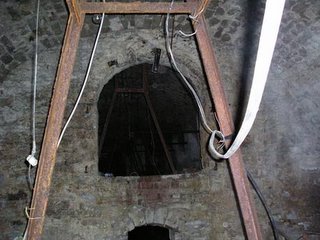 the sidewalks above through a grate. Chris and I had noticed this grate as we walked the street above earlier. "I wonder where that goes," I said, after which he replied "Somewhere I want to be!" There were many leftover metal frams, as you can see from the pictures. I am not sure what these were used for. The caves were at one time almost certainly used as a lagering cellar, as most of the St. Louis caves were at one time or another. Confident that we had seen all there was to see of the Consumer's Brewery Cave (it's not that large, and we unfortunately didn't bring a raft to navigate the flooded parts), Chris and I decided to head back up and begin exploring the rest of the facility.
the sidewalks above through a grate. Chris and I had noticed this grate as we walked the street above earlier. "I wonder where that goes," I said, after which he replied "Somewhere I want to be!" There were many leftover metal frams, as you can see from the pictures. I am not sure what these were used for. The caves were at one time almost certainly used as a lagering cellar, as most of the St. Louis caves were at one time or another. Confident that we had seen all there was to see of the Consumer's Brewery Cave (it's not that large, and we unfortunately didn't bring a raft to navigate the flooded parts), Chris and I decided to head back up and begin exploring the rest of the facility.



 I was amazed at the amount of equipment that still remains inside the facility. Chris and I took our time, wandering into every room and admiring the large brewing tanks and all the strange gauges and switches. The main staircase in the building was made of cast iron, and we couldn't believe that it had not been stripped and sold. Despite it's extremely rickety look and the fact that it was missing a few steps on the lowest level, it was quite sturdy. Interestingly enough, it seemed to get better and better as we got higher and higher. Every time we got to a new level, we couldn't believe when we saw that the stairs continued to go up. I lost track of how many different levels we climbed. One of the rooms a few floors up appeared to be some kind of laboratory .... perhaps a beer laboratory? There were many test tubes and containers.....then again, it could have also been someone's meth lab at one time. I don't know too much about that kind of stuff. Near the top of the first building, Chris and I climbed through a hallway that was full of rubble two feet high, and came to a tile room with a church-like shape. We were convinced that we had found thier secret "beer chapel," but after finding
I was amazed at the amount of equipment that still remains inside the facility. Chris and I took our time, wandering into every room and admiring the large brewing tanks and all the strange gauges and switches. The main staircase in the building was made of cast iron, and we couldn't believe that it had not been stripped and sold. Despite it's extremely rickety look and the fact that it was missing a few steps on the lowest level, it was quite sturdy. Interestingly enough, it seemed to get better and better as we got higher and higher. Every time we got to a new level, we couldn't believe when we saw that the stairs continued to go up. I lost track of how many different levels we climbed. One of the rooms a few floors up appeared to be some kind of laboratory .... perhaps a beer laboratory? There were many test tubes and containers.....then again, it could have also been someone's meth lab at one time. I don't know too much about that kind of stuff. Near the top of the first building, Chris and I climbed through a hallway that was full of rubble two feet high, and came to a tile room with a church-like shape. We were convinced that we had found thier secret "beer chapel," but after finding temperature gagues near the doorway, realized that it was probably some kind of cold storage. It just seemed unusual that a cold storage room would have windows, or such an elaborate shape. From this room we reached the first of roof of the day, which offered us an amazing panoramic of the St. Louis skyline. We could clearly see the old City Hospital just a half mile away, and in the other direction the Budweiser and Lemp Breweries reminded us of how important the production of beer was and continues to be to St. Louis. As we looked back in to the complex, we noticed that the roof of one of the buildings had completely caved in, and taken the uppermost floors with it! There are still parts
temperature gagues near the doorway, realized that it was probably some kind of cold storage. It just seemed unusual that a cold storage room would have windows, or such an elaborate shape. From this room we reached the first of roof of the day, which offered us an amazing panoramic of the St. Louis skyline. We could clearly see the old City Hospital just a half mile away, and in the other direction the Budweiser and Lemp Breweries reminded us of how important the production of beer was and continues to be to St. Louis. As we looked back in to the complex, we noticed that the roof of one of the buildings had completely caved in, and taken the uppermost floors with it! There are still parts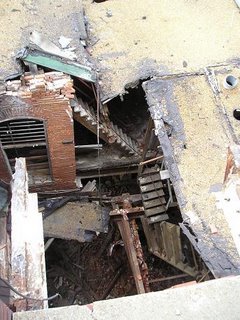 of the staircases that are left hanging, dangling stories above the floor. We didn't try those staircases.
of the staircases that are left hanging, dangling stories above the floor. We didn't try those staircases.
We then visited some of the other buildings in the complex. As we descended a stairwell and into a hallway, we realized that it was taking us underneath the street. The Brewery had buildings on both sides of the street, and I guess this was how they went back and forth. The building across the street was fairly uninteresting, mainly just a lot of fermenting tanks on every floor, so much so that they began to look exactly alike.
Back across the street, we found one of the highlights of the trip. Wandering a hallway, I found a piece of paper on the ground. As I turned it over, Chris realized that it was a Falstaff stock certificate. We were both pondering where this could come from when we turned a corner into the next room and our question was immediately answered. It appeared that every piece of paperwork that Falstaff had ever collected could be found in this one room. There were more file boxes and piles of moldy and decomposing paper and shelves of books tha n I had ever seen in one place. The room was easily the size of a small gym, and boxes were stacked as high as our heads in some places. While much of the paperwork was in pretty bad shape, there was a fair amount that remains pretty intact.
n I had ever seen in one place. The room was easily the size of a small gym, and boxes were stacked as high as our heads in some places. While much of the paperwork was in pretty bad shape, there was a fair amount that remains pretty intact.
Later on, Chris and I found another room with church-like qualities. It seemed to be some kind of lobby or reception area, and the ceiling looked like something you'd see in an art museum, with columned arches. This was the only area of the entire brewery that looked like this, which made it all the more interesting. The plaster was crumbling many places, and the wood paneling seemed to be falling apart , but it was interesting to imagine what this room would have looked like in it's prime.
, but it was interesting to imagine what this room would have looked like in it's prime.
The Falstaff Brewery was, without a doubt, the most interesting and massive site that I have explored to date. We spent hours getting lost in the mazes of hallways and rooms that it provided, and I still feel like there is much to see. I know of no future plans for the site. One part of it is being used in some respect, most likely for some kind of shipping dock. The rest, sadly, will continue to deteriorate. That, or the city will make it into lofts. The seem to be doing that quite a bit lately.

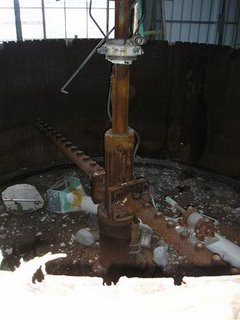
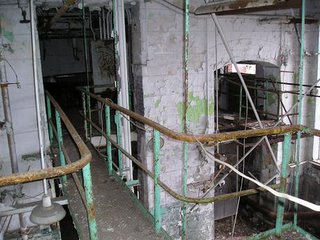
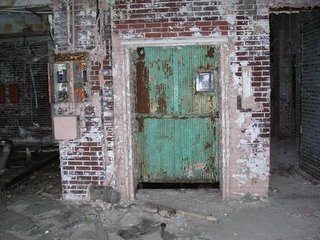
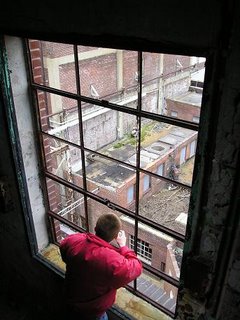





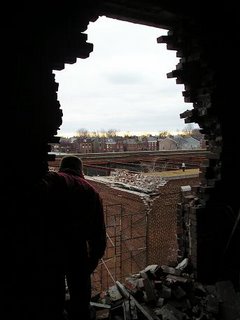
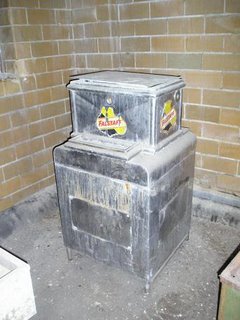
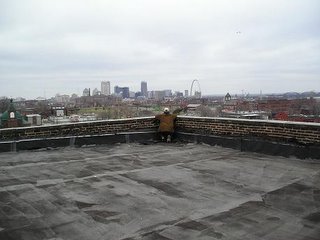 Our fitting conclusion to this memorable day was our outstanding dinner at O'Malley's Irish Pub. My cheese burger was top notch, and Chris assurses me that his roast beef au jus was as well.
Our fitting conclusion to this memorable day was our outstanding dinner at O'Malley's Irish Pub. My cheese burger was top notch, and Chris assurses me that his roast beef au jus was as well.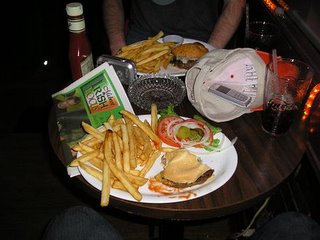
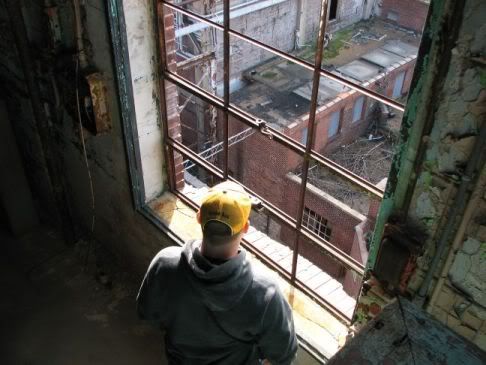

6 Comments:
Sweet. Man, you ain't kiddin' -- how have I never noticed this place??
I went in there last night we some buddies, it was quite an amazing place, sadly I did not see any of the church rooms you talked about. We were shocked when we found our selfs on the roof of that building across the street.
I come from long line of Falstaff employees. My grandfather and dad worked for Falstaff. I worked at plant ten after Falstaff took over it either in 1958 or 59. I worked in the office garage and the bottle shop and brew house lBS. I remember walking down to the caves several times.
Isn't this commonly--if incorrectly--referred to by locals as the "Lemp Brewery?"
I live in Soulard and I've known about this place for years and yet I didn't know you could just walk into it like that. I'd love to get some people together and do a tour of this place. I love old building complexes and I love the look and feel of the Lemp Brewery. What a waste to see this amazing structure sitting vacant for so long. Anybody up for organizing a trip?
I’d like to
Join you
Post a Comment
<< Home